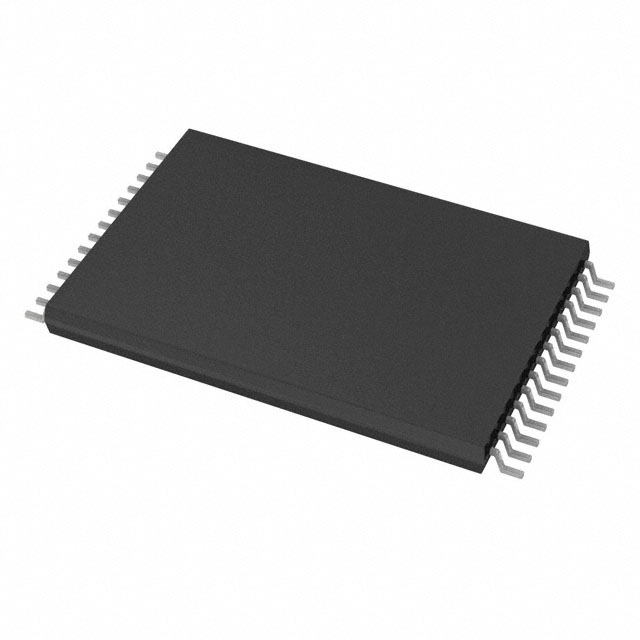AT28C256-15TC
Product Overview
Category
AT28C256-15TC belongs to the category of non-volatile memory devices.
Use
It is primarily used for storing and retrieving digital information in electronic systems.
Characteristics
- Non-volatile: Retains data even when power is removed.
- High storage capacity: 256 kilobits (32 kilobytes).
- Fast access time: Operates at a speed of 150 nanoseconds.
- Low power consumption: Designed to minimize energy usage.
- Durable: Can withstand multiple read and write cycles without degradation.
Package
AT28C256-15TC is available in a standard 28-pin Thin Small Outline Package (TSOP).
Essence
The essence of AT28C256-15TC lies in its ability to provide reliable and non-volatile storage for electronic systems.
Packaging/Quantity
This product is typically sold in reels or tubes, with each containing a specific quantity of AT28C256-15TC chips.
Specifications
- Memory Capacity: 256 kilobits (32 kilobytes)
- Access Time: 150 nanoseconds
- Supply Voltage: 4.5V - 5.5V
- Operating Temperature Range: -40°C to +85°C
- Data Retention: 10 years
Detailed Pin Configuration
- A0: Address Input
- A1: Address Input
- A2: Address Input
- A3: Address Input
- A4: Address Input
- A5: Address Input
- A6: Address Input
- A7: Address Input
- A8: Address Input
- A9: Address Input
- A10: Address Input
- A11: Address Input
- A12: Address Input
- A13: Address Input
- A14: Address Input
- A15: Address Input
- /OE: Output Enable
- /WE: Write Enable
- /CE: Chip Enable
- VCC: Power Supply
- DQ0: Data Input/Output
- DQ1: Data Input/Output
- DQ2: Data Input/Output
- DQ3: Data Input/Output
- DQ4: Data Input/Output
- DQ5: Data Input/Output
- DQ6: Data Input/Output
- DQ7: Data Input/Output
Functional Features
- Random access memory: Allows data to be read from or written to any location within the memory array.
- Byte-wise operations: Supports individual byte read and write operations.
- Hardware and software protection: Provides mechanisms to prevent accidental modification of stored data.
- High reliability: Offers robust performance and long-term data retention.
Advantages and Disadvantages
Advantages
- Non-volatile storage: Retains data even without power supply.
- Fast access time: Enables quick retrieval of information.
- Low power consumption: Helps conserve energy in electronic systems.
- Durable: Can withstand multiple read and write cycles without degradation.
Disadvantages
- Limited storage capacity: May not be suitable for applications requiring larger memory sizes.
- Relatively slower compared to some modern memory technologies.
- Sensitive to environmental conditions such as temperature and humidity.
Working Principles
AT28C256-15TC utilizes a combination of electronic circuits and semiconductor technology to store and retrieve digital information. It employs a grid-like structure of transistors and capacitors to represent and store binary data.
The memory cells are organized into an array, with each cell capable of storing one bit of information. The address lines are used to select a specific memory location, while the data lines facilitate reading from or writing to that location.
Detailed Application Field Plans
AT28C256-15TC finds applications in various electronic systems, including but not limited to: - Microcontrollers - Embedded systems - Industrial automation - Automotive electronics - Consumer electronics
Its ability to provide non-volatile storage makes it suitable for applications where data retention is crucial, such as firmware storage, program code storage, and data logging.
Detailed and Complete Alternative Models
Some alternative models to AT28C256-15TC include: - AT28C256-12PC - AT28C256-20PI - AT28C256-25DM/883
These models offer similar functionality and characteristics, but may differ in terms of access time, package type, or operating temperature range. It is important to consider specific requirements and compatibility when selecting an alternative model.
Word count: 570 words
Senaraikan 10 soalan dan jawapan biasa yang berkaitan dengan aplikasi AT28C256-15TC dalam penyelesaian teknikal
Sure! Here are 10 common questions and answers related to the application of AT28C256-15TC in technical solutions:
Q: What is the AT28C256-15TC? A: The AT28C256-15TC is a 32K x 8 low-power CMOS EEPROM (Electrically Erasable Programmable Read-Only Memory) chip.
Q: What is the operating voltage range for the AT28C256-15TC? A: The AT28C256-15TC operates within a voltage range of 4.5V to 5.5V.
Q: How much data can the AT28C256-15TC store? A: The AT28C256-15TC has a storage capacity of 256 kilobits, which is equivalent to 32 kilobytes.
Q: What is the access time of the AT28C256-15TC? A: The AT28C256-15TC has an access time of 150 nanoseconds.
Q: Can the AT28C256-15TC be reprogrammed? A: Yes, the AT28C256-15TC is electrically erasable and programmable, allowing it to be reprogrammed multiple times.
Q: What is the temperature range for the AT28C256-15TC? A: The AT28C256-15TC can operate within a temperature range of -40°C to +85°C.
Q: What interface does the AT28C256-15TC use? A: The AT28C256-15TC uses a standard parallel interface for data transfer.
Q: Is the AT28C256-15TC compatible with 5V systems? A: Yes, the AT28C256-15TC is designed to be compatible with both 5V and 3.3V systems.
Q: Can the AT28C256-15TC retain data without power? A: Yes, the AT28C256-15TC has a built-in power-down feature that allows it to retain data for up to 10 years without power.
Q: What are some typical applications of the AT28C256-15TC? A: The AT28C256-15TC is commonly used in various technical solutions such as embedded systems, industrial control systems, automotive electronics, and consumer electronics where non-volatile memory storage is required.
Please note that these answers are general and may vary depending on specific use cases and requirements.


